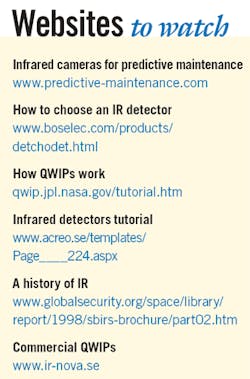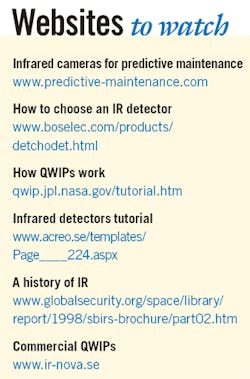Looking at infrared detectors
For many years all the major breakthroughs in infrared (IR) technology have been funded by military sponsors,” says Jan Andersson, manager of the Nanoelectronics Department at Acreo (Kista, Sweden; www.acreo.se). “Consequently, high-performance IR systems have predominantly used cooled photon detectors.” Now, however, IR systems also are being used in civilian applications such as machine vision, where lower-performance uncooled systems have been developed. Other markets for uncooled IR detector arrays include driver’s aids for automobiles, surveillance systems, medical diagnostics, and robotic manufacturing systems.
“IR imaging is usually performed in either the 400-1700-nm short-wavelength IR (SWIR), 3-5-µm medium-wavelength IR (MWIR), or 8-12-µm range long-wavelength IR (LWIR) region,” Andersson says. “However, some applications, such as gas analysis, are performed at wavelengths where the radiation absorption is a maximum, for example, 4.2 µm for carbon dioxide and around 6 µm for water vapor.”
Two types of detectors are currently used in IR systems: photon detectors and thermal detectors. Due to the different types of noise-generation-recombination noise in photon detectors and temperature fluctuation noise in thermal detectors-these two classes of detectors have different efficiencies that depend on wavelength and temperature. While photon detectors are usually deployed in LWIR systems, they require cooling. Thermal detectors can operate at room temperature but their sensitivity is lower and the response time longer than photon detectors.
Photon detectors
“In most cases photon detectors need to be cooled to cryogenic temperatures,” says Andersson. “In some cases, thermoelectric cooling down to 200 K is sufficient. Mercury cadmium telluride (HgCdTe) is used both for the MWIR and LWIR atmospheric transmission windows, whereas indium antimonide (InSb) is used only in the 3-5-µm range. Large platinum silicide (PtSi) focal-plane arrays (FPAs) also have been used in the MWIR range despite their low quantum efficiency.”
“In the last five years, bandgap-engineered detectors based on low-dimensional structures have evolved as viable candidates for FPAs, especially for LWIR imaging. The most mature of these is the aluminum gallium arsenide/gallium arsenide (AlGaAs/GaAs) quantum-well IR photoconductor (QWIP) structure that requires operating temperatures around 70 K-75 K that are easily achieved using miniature Stirling coolers,” Andersson says. Indeed, in March 2007 Acreo spun-off its QWIP detector technology activity to IRnova (Kista, Sweden; www.ir-nova.se), which will further develop products based on both QWIP and superlattice technology.
“In theory, InAs/GaInSb, or so-called type-II superlattices, can offer high sensitivity,” says Andersson. “In addition, uniformity is expected to be superior to III-VI materials such as HgCdTe, but at present the detector technology is far from comparable with HgCdTe technology.”
Detector arrays operated as FPAs using these technologies are fairly complicated to fabricate, and the signals from the detector require analog-to-digital conversion external to the detector array. While some of these detector elements are often fabricated from exotic materials such as HgCdTe, exceptions include PtSi or microbolometer devices that are based on silicon technology.
In the first case, a hybrid approach is most common, in which all the detector pixels are fabricated from a separate detector chip. This is then flip-chip bonded to a readout integrated circuit (ROIC) that is usually fabricated using CMOS technology. Flip-chip bonding involves the processing of metal bumps onto contact holes, one per pixel, of both the detector chip and the ROIC.
Using special equipment, the two chips are first aligned to each other. Then the chips are put in contact, while applying heat and/or mechanical force. During this process the two chips become electrically connected to each other via the metal bumps.
Thermal detectors
“In contrast to photon detectors, the operation of thermal detectors depends on a two-step process,” says Andersson. “The absorption of IR radiation in these detectors raises the temperature of the device, which, in turn, changes some temperature-dependent parameter such as electrical conductivity. The major advantage of thermal detectors is that they can operate at room temperature. However, the sensitivity is lower and the response time longer than photon detectors. This makes thermal detectors suitable for FPA operation, where the latter two properties are less critical. Thermal detectors include pyroelectric, thermopile, and bolometer-based detectors,” he says.
Pyroelectric materials such as tri-glycine sulphate (TGS), lithium tantalate (LiTaO3), and lead zinc titanate (PZT) also can be used to fabricate thermal detectors. Fabricating a capacitor from these materials and sensing the variation of charge with temperature allows passive IR measurements to be made.
Thermoelectric devices such as thermocouples or thermopiles are based on the presence of one or several junctions between two materials. These junctions develop a thermal-EMF that changes with temperature, the so-called Seebeck effect. For the sensitivity to be high, the Seebeck coefficient must be as high as possible. Certain alloys containing antimony and bismuth have high Seebeck coefficients of 150 µV/K. The CMOS-compatible combination of aluminum and polycrystalline silicon, for example, provides about 65 µV/K.
“In contrast, resistive bolometers contain a material whose resistivity changes with temperature,” says Andersson. ”To achieve high sensitivity, the temperature coefficient of the resistivity must be as large as possible, and the noise resulting from contacts and the material itself must be low. Such resistive materials can include metals such as platinum,or semiconductors (thermistors). While metal-based devices exhibit low noise, they also feature low temperature coefficients (about 0.2 %/K); semiconductors have high temperature coefficients (1%-4%/K) they are prone to be noisier.”

